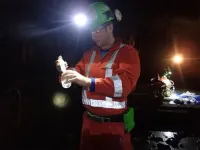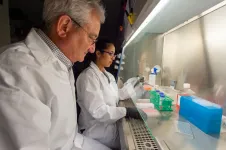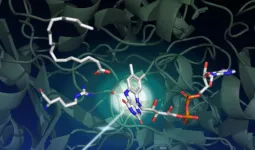Mars has right ingredients for present-day microbial life beneath its surface, study finds
2021-04-22
(Press-News.org) PROVIDENCE, R.I. [Brown University] -- As NASA's Perseverance rover begins its search for ancient life on the surface of Mars, a new study suggests that the Martian subsurface might be a good place to look for possible present-day life on the Red Planet.
The study, published in the journal Astrobiology, looked at the chemical composition of Martian meteorites -- rocks blasted off of the surface of Mars that eventually landed on Earth. The analysis determined that those rocks, if in consistent contact with water, would produce the chemical energy needed to support microbial communities similar to those that survive in the unlit depths of the Earth. Because these meteorites may be representative of vast swaths of the Martian crust, the findings suggest that much of the Mars subsurface could be habitable.
"The big implication here for subsurface exploration science is that wherever you have groundwater on Mars, there's a good chance that you have enough chemical energy to support subsurface microbial life," said Jesse Tarnas, a postdoctoral researcher at NASA's Jet Propulsion Laboratory who led the study while completing his Ph.D. at Brown University. "We don't know whether life ever got started beneath the surface of Mars, but if it did, we think there would be ample energy there to sustain it right up to today."
In recent decades, scientists have discovered that Earth's depths are home to a vast biome that exists largely separated from the world above. Lacking sunlight, these creatures survive using the byproducts of chemical reactions produced when rocks come into contact with water.
One of those reactions is radiolysis, which occurs when radioactive elements within rocks react with water trapped in pore and fracture space. The reaction breaks water molecules into their constituent elements, hydrogen and oxygen. The liberated hydrogen is dissolved in the remaining groundwater, while minerals like pyrite (fool's gold) soak up free oxygen to form sulfate minerals. Microbes can ingest the dissolved hydrogen as fuel and use the oxygen preserved in the sulfates to "burn" that fuel.
In places like Canada's Kidd Creek Mine, these "sulfate-reducing" microbes have been found living more than a mile underground, in water that hasn't seen the light of day in more than a billion years. Tarnas has been working with a team co-led by Brown University professor Jack Mustard and Professor Barbara Sherwood Lollar of the University of Toronto to better understand these underground systems, with an eye toward looking for similar habitats on Mars and elsewhere in the solar system. The project, called Earth 4-D: Subsurface Science and Exploration, is supported by the Canadian Institute for Advances Research.
For this new study, the researchers wanted to see if the ingredients for radiolysis-driven habitats could exist on Mars. They drew on data from NASA's Curiosity rover and other orbiting spacecraft, as well as compositional data from a suite of Martian meteorites, which are representative of different parts of the planet's crust.
The researchers were looking for the ingredients for radiolysis: radioactive elements like thorium, uranium and potassium; sulfide minerals that could be converted to sulfate; and rock units with adequate pore space to trap water. The study found that in several different types of Martian meteorites, all the ingredients are present in adequate abundances to support Earth-like habitats. This was particularly true for regolith breccias -- meteorites sourced from crustal rocks more than 3.6 billion years old -- which were found to have the highest potential for life support. Unlike Earth, Mars lacks a plate tectonics system that constantly recycle crustal rocks. So these ancient terrains remain largely undisturbed.
The researchers say the findings help make the case for an exploration program that looks for signs of present-day life in the Martian subsurface. Prior research has found evidence of an active groundwater system on Mars in the past, the researchers say, and there's reason to believe that groundwater exists today. One recent study, for example, raised the possibility of an underground lake lurking under the planet's southern ice cap. This new research suggests that wherever there's groundwater, there's energy for life.
Tarnas and Mustard say that while there are certainly technical challenges involved in subsurface exploration, they aren't as insurmountable as people may think. A drilling operation wouldn't require "a Texas-sized oil rig," Mustard said, and recent advances in small drill probes could soon put the Martian depths within reach.
"The subsurface is one of the frontiers in Mars exploration," Mustard said. "We've investigated the atmosphere, mapped the surface with different wavelengths of light and landed on the surface in half-a-dozen places, and that work continues to tell us so much about the planet's past. But if we want to think about the possibility of present-day life, the subsurface is absolutely going to be where the action is."
INFORMATION:
The research was supported by the Canadian Institute for Advanced Research.
[Attachments] See images for this press release:

ELSE PRESS RELEASES FROM THIS DATE:
2021-04-22
The unprecedented development of COVID-19 vaccines less than a year after discovery of this virus was enabled by more than $17 billion of research on vaccine technologies funded by the NIH prior to the pandemic, according to new research from Bentley University's Center for Integration of Science and Industry. The article, titled "NIH funding for vaccine readiness before the COVID-19 pandemic," demonstrates the critical role this broad foundation of government-funded research plays in ensuring vaccine readiness.
The report, published today in the journal Vaccine, ...
2021-04-22
DALLAS - April 22, 2021 - Being Black or Hispanic, living in high-poverty neighborhoods, and having Medicaid or no insurance coverage are associated with higher mortality in men and women under 40 with cancer, a review by UT Southwestern Medical Center researchers found.
"Survival is not different because of biology. It's not different because of patient-level factors," says Caitlin Murphy, Ph.D., lead author of the study and an assistant professor of population and data sciences and internal medicine at UT Southwestern. "No matter which way we looked at the data, we still saw consistent and alarming differences in survival by race - and these are teens and young adults."
Other findings based on an ...
2021-04-22
Machine learning could provide up an extra hour of warning time for debris flows along the Illgraben torrent in Switzerland, researchers report at the Seismological Society of America (SSA)'s 2021 Annual Meeting.
Debris flows are mixtures of water, sediment and rock that move rapidly down steep hills, triggered by heavy precipitation and often containing tens of thousands of cubic meters of material. Their destructive potential makes it important to have monitoring and warning systems in place to protect nearby people and infrastructure.
In her presentation at SSA, Ma?gorzata Chmiel of ETH Zürich described a machine learning approach to detecting and alerting against debris flows for the Illgraben torrent, a site in the European Alps that experiences significant debris flows and torrential ...
2021-04-22
It seems like a smooth slab of stainless steel, but look a little closer, and you'll see a simplified cross-section of the Los Angeles sedimentary basin.
Caltech researcher Sunyoung Park and her colleagues are printing 3D models like the metal Los Angeles proxy to provide a novel platform for seismic experiments. By printing a model that replicates a basin's edge or the rise and fall of a topographic feature and directing laser light at it, Park can simulate and record how seismic waves might pass through the real Earth.
In her presentation at the Seismological Society of America (SSA)'s 2021 Annual Meeting, Park explained why these physical models can address some of the drawbacks of numerical modeling of ground motion in some cases.
Small-scale, complex structures in ...
2021-04-22
Days after the 4 August 2020 massive explosion at the port of Beirut in Lebanon, researchers were on the ground mapping the impacts of the explosion in the port and surrounding city.
The goal was to document and preserve data on structural and façade damage before rebuilding, said University of California, Los Angeles civil and environmental engineer Jonathan Stewart, who spoke about the effort at the Seismological Society of America (SSA)'s 2021 Annual Meeting.
The effort also provided an opportunity to compare NASA Jet Propulsion Laboratory satellite surveys of the blast effects with data collected from the ground surveys. Stewart and his colleagues concluded that satellite-based Damage Proxy Maps were effective at identifying severely damaged buildings and undamaged ...
2021-04-22
Research has identified critical factors that enable dangerous bacteria to spread disease by surviving on surfaces in hospitals and kitchens.
The study into the mechanisms which enable the opportunistic human pathogen Pseudomonas aeruginosa to survive on surfaces, could lead to new ways of targeting harmful bacteria.
To survive outside their host, pathogenic bacteria must withstand various environmental stresses. One mechanism is the sugar molecule, trehalose, which is associated with a range of external stresses, particularly osmotic shock - sudden changes to the salt concentration surrounding cells.
Researchers ...
2021-04-22
EUGENE, Ore. -- April 22, 2021 -- Product marketers should be clear in their messaging to avoid customer skepticism that makes them feel duped, according to University of Oregon research.
At issue in a new study, published in the Journal of Business Research, was a social-cognitive construct called theory of mind, which considers how well people assess the mental states and apparent goals of others.
Developmental psychologists link it to an ability to show empathy. In business, the study, led by former UO doctoral student Elizabeth Minton, showed it also can influence a person's recognition of being persuaded. And that affects a person's evaluation and willingness to buy a product, she found.
"There has been some research on adult theory of mind, particularly in understanding ...
2021-04-22
Severity of illness, history of stroke, and being divorced or widowed were independently predictive of delirium in hospitalized patients in Zambia, according to a study published in PLOS ONE.
A collaborative team of researchers from Vanderbilt University Medical Center and the University of Zambia Teaching Hospital published the risk factors as a follow-up look at the prevalence and impact of delirium, a form of acute brain dysfunction, in lower-resourced hospitals. Findings published in February showed delirium is widespread in patients admitted to the University Teaching Hospital, and the duration of delirium predicted both mortality and disability at six months after discharge.
The studies represent ...
2021-04-22
PHILADELPHIA -- (April 22, 2021) -- A synthetic DNA vaccine candidate for Middle East respiratory syndrome coronavirus (MERS-CoV) developed at The Wistar Institute induced potent immune responses and afforded protective efficacy in non-human primate (NHP) models when given intradermally in abbreviated, low-dose immunization regimen. A similar vaccine candidate was previously shown to be safe and tolerable with a three-dose intramuscular injection regimen in a recently completed human phase 1 study and is currently in expanded studies of phase 1/2a trial. ...
2021-04-22
Although many organisms capture and respond to sunlight, enzymes - proteins that catalyze biochemical reactions - are rarely driven by light. Scientists have identified only three types of natural photoenzymes so far. The newest one, discovered in 2017, is fatty acid photodecarboxylase (FAP). Derived from microscopic algae, it uses blue light to catalyze the conversion of fatty acids, found in fats and oils, into alkanes and alkenes.
"A growing number of labs envision using FAPs for green chemistry applications, because alkanes and alkenes are important components of solvents and fuels, including gasoline ...
LAST 30 PRESS RELEASES:
[Press-News.org] Mars has right ingredients for present-day microbial life beneath its surface, study finds







